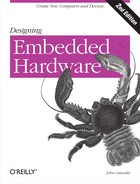Colophon
About the Author. John Catsoulis lives under the tropical sun in Brisbane, Australia. He has a Bachelor of Science with Honors (Griffith University) with a triple major in quantum physics, electronics, and mathematics, and a Master of Engineering (La Trobe University) in specialized computer architectures. He has been responsible for the design of more computer systems than he can remember, from tiny finger-sized machines to multiprocessor compute engines. Corporations and government bodies around the world have used his designs and software. John has also taught the dark arts of computer architecture and design at several universities. He is currently conducting research at the University of Queensland into fault-tolerant reconfigurable computers for spacecraft avionics.
When not slaving over a hot microprocessor, John enjoys hiking and camping, wildlife and landscape photography, fishing, dabbling in permaculture, cooking Indian and Mediterranean food, and playing model trains with his nephews, Andrew and James.
Our look is the result of reader comments, our own experimentation, and feedback from distribution channels. Distinctive covers complement our distinctive approach to technical topics, breathing personality and life into potentially dry subjects.
The animal on the cover of Designing Embedded Hardware, Second Edition is a porcelain crab. These tiny invertebrates are common in tide pools along the coast of the Pacific Ocean. They are an orangy brown color, and are only five millimeters long. Porcelain crabs have six pairs of legs, with one tiny pair tucked in across the base of the tail. Although they can swim, sharply pointed spines on the ends of their walking legs make it easier for them to cling to the hard surfaces of submerged rocks. Hair on their legs collects mud from the ocean floor and helps camouflage the crab from predators. Additional protection is provided by mussel beds, sponges, and algae. Once concealed in these preferred habitats, the porcelain crab sweeps its feathery arms through the water, capturing plankton and other tiny plants and animals. When threatened by a predator, these crabs can detach a leg or claw to distract an attacker. The tricky crab scurries away, and its lost appendage eventually grows back.
Sanders Kleinfeld was the production editor and copyeditor for Designing Embedded Hardware, Second Edition. Matt Hutchinson proofread the book. Genevieve d’Entremont and Colleen Gorman provided quality control. Julie Hawks wrote the index.
Emma Colby designed the cover of this book, based on a series design by Edie Freedman. The cover image is a 19th-century engraving from Cuvier’s Animals. Karen Montgomery produced the cover layout with Adobe InDesign CS using Adobe’s ITC Garamond font.
David Futato designed the interior layout. This book was converted by Joe Wizda to FrameMaker 5.5.6 with a format conversion tool created by Erik Ray, Jason McIntosh, Neil Walls, and Mike Sierra that uses Perl and XML technologies. The text font is Linotype Birka; the heading font is Adobe Myriad Condensed; and the code font is LucasFont’s TheSans Mono Condensed. The illustrations that appear in the book were produced by Robert Romano, Jessamyn Read, and Lesley Borash using Macromedia FreeHand MX and Adobe Photoshop CS. The tip and warning icons were drawn by Christopher Bing. This colophon was written by Philip Dangler.
